![]() 1st Battalion 22nd Infantry
1st Battalion 22nd Infantry ![]()
22nd Infantry - Medical Company 1950-1951
Training
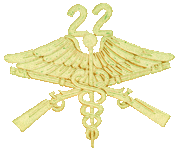
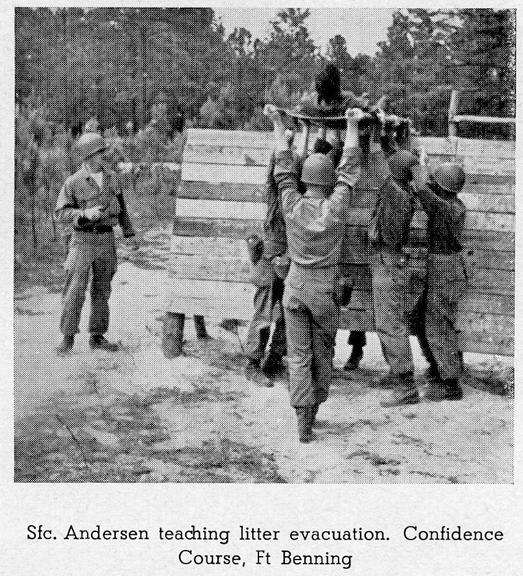
TRAINING
Sfc. Andreas W. Andersen
The prelude to training in Medical Company, 22nd Infantry Regiment began shortly after the first of the year 1951.
This consisted of refresher
training for the cadre for it was important that they be abreast
of the latest teaching techniques
in order to be able to interest the new men. Among the subjects
were: Anatomy and Physiology, First Aid, Technique
of Instruction and Map Reading.
The new men began to arrive
after the first of the year, and in one week were enough to begin
preliminary classes to accustom
the cadre to instructing before a large group.
Finally, 15 January, 1951
settled down to formal training. All of the new men had had their
basic training in various training centers
througout the country. This meant that the bulk of the training
had to be in the medical vein.
The medical trainees were taught
the numerous ways to transport sick and wounded both in combat
and emergency situations.
Everyone had a chance to practice evacuation proceedures.
The most complicated of the new
subjects was Anatomy and Physiology taught by Lt.Mitchell. For
the majority, this meant
learning medical jargon. They learned to call a collar bone a
clavicle. Soon they had a good idea of the human body and how it
worked.
Everyone will remember Capt.
Kato's Emergency Care and this along with another one, First Aid,
the treatment for shock,
hemorrhage, fractures, burns, etc. was stressed many times in
order to make an indelible impression, so lasting, that each man
would act correctly by habit.
The break-down of the Medical
Department was taught by Sfc. Luneack, with special emphasis on
field units. This pertained
primarily to the sections of Medical Company, the latter included
the line of evacuation from the perimeter to the ZI.
One subject few of the men could
understand was Ward Management and Nursing Care. They could not
comprehend an aid man
worrying about enemas and bed making. During the WM and NC
course, the men learned to count pulses, read temperatures,
gauge blood pressure and employ sterile technique in their work.
Military subjects constantly
were stressed, impressing upon the men that they were infantry
medics. For their protection,
they were taught to move quietly and to avoid observation by the
enemy They were told many times that a bullet could be
meant for them just as well as a rifleman.
Toward the end of this maze of
new subjects came the bivouac. Each man went with his assigned
rifle platoon into the woods
where he did the job that was given to him. Some went with a
company of infantry, some with an aid station and some as litter
men.
Everyone had a chance to see and to understand why they were
being trained in such a manner back at the post. Each aid man
was with his rifle platoon on the range, on night marches and all
tactical problems. They learned the pleasant fact that they were
the "Doc", the person to whom the men came with
anything from blisters to personal problems. There was one night
move
and the long march back to Harmony Church. The bivouac had
fulfilled a worthy purpose by teaching the men to appreciate
the purpose behind the training they had received thus far. The
men will always remember the classes on the now familier EMT.
The three types of field medical records were drilled into the
men's minds time and time again. The necessity for security
was stressed; the importance of not leaving telltale evidence
about after writing up an injured or wounded man. The men
were informed that a wounded man's records followed him through
the entire channel of evacuation. It was mandatory,
therefore, that they be accurate in making entries relating to
treatment given their patients, carelessness could mean
death for the casualty.
It was interesting to watch the
awkward way in which most of the men applied complicated bandages
for the first time.
With practice the men became skilled in the art of bandaging.
During the practical application
of class room work, the men had a lot of fun trying to evacuate a
man up and down a cliff.
Once, the rope broke, another time, Ramaley slipped out of a
strap and was left dangling by his shoulders at the top of the
cliff.
Evacuation across a stream by means of cable and winch also was
practiced.
Stream beds were used to stress the use of cover and concealment.
Lt. Jacobs gave several classes
on supply economy and logistics. But the men still had lame
excuses to account for items
lost on bivouac. Signing of statements of charges caused them to
take greater care of their equipment.
(Later in Germany they were to find that even tent pins could be
critical items.)
The pay off came when all the
men had to give each other shots. A field sterilizer was set up
in the class room while the men
were lined up outside. Then they were paired off. Each had to
give the other a 2cc injection of distilled water. The only thing
that apparently bothered them was the burning caused by the use
of sterile distilled water instead of sterile normal saline
solution.
Another subject that caused some
consternation was Pharmacy taught by Sgt. Andersen. As with
Anatomy and Physiology,
a new lingo had to be learned. Carbolic acid became phenol,
aspirin became acetylsalisylic acid and cascara became
cascara sagrada. In order to recognize the drugs that came in the
No. 2 chest and their personal medical aid kits,
they learned that each drug had a separate classification with
respect to its action on the human body They were taught
that an aspirin was an analgesic, and that an analgesic allayed
pain, that morphine was a hypnotic, because it induced sleep;
and that each laxative had its own classification. Poisons and
antidotes were given along with Latin symbols for the writing of
prescriptions.
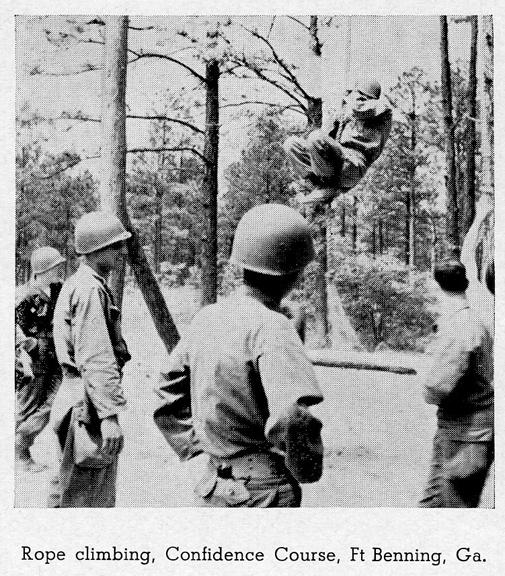
Many men will long remember the
first class in suturing which took place in the draw by the first
company area. A piece of
bacon rind from the mess hall was used to simulate human skin.
They found all the necessary instruments and sutures in their aid
kits.
They will also recall Rope climbing, Confidence Course, Ft
Benning, Ga. when they learned to handle a syringe and hypodermic
needle
with forceps, and the reason for doing so. Both of these subjects
gave quite a few men trouble, but now most of them are
proficient.
Cpl. Weller gave a series of lectures on Atomic Energy and the action to follow in the event of an atomic attack.
A number of classes on Plasma
were given by Sgts. Lannigan and A. Russell and each man had the
opportunity of seeing
the dried human plasma mixed with sterile distilled water and of
observing the precautions necessary to prevent contamination
during the mixing. They found the importance attached to the
subject was due to the fact that in the field, sterile technique
must be followed as much as posssible. The plasma sets are made
in such a manner to allow for this situation. The men
were also trained to administer to their patients as they were
being evacuated by litter and litter jeep.
The primary prerequisite of a
good soldier is a thorough knowledge of Military Courtesy. This
subject has been on the
training schedule often and probably will continue in the future.
Proper respect for the Flag, Officers, and Officers of
friendly nations was taught. The proper means of reporting to an
officer for pay, etc. was continually stressed by Sgt. Long.
One subject most men liked was
Tactics. They had an opportunity to use initiative. They gained
more practice in evacuating
simulated wounded men from hill sides. The aid station was
constantly being moved in the middle of the problems to afford
training in communication and control. Ex-combat men like Sgt. A.
Russell, Sgt. Lannigan, Sfc. St. John, Sfc. Brown
and Sgt. Rowell were on hand to give men advice. The numerous
hours of, scouting and patrolling were brought into play
by Sgt. Ingrum. They were taught ways and means of reaching a
wounded doughboy under fire; and when there, how
to treat his wounds and get him to a safe area. The different
methods of evacuation were utilized to bring the problems
to a successful conclusion.
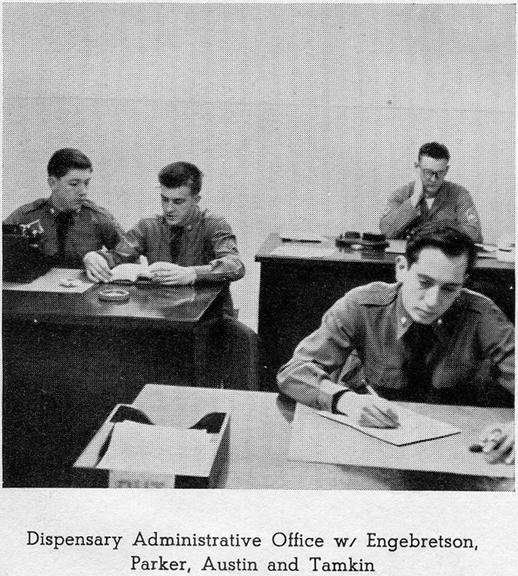
Thorough training came
temporarily to a close for it was time to move out for Camp
Kilmer. But before anyone could go,
they had to undergo certain POM requirements. Among them were
bringing their shot records up to date; qualifying on the
rifle range and transition course, close combat range and combat
in towns.
The medics travelled on
different trains. They were, once again, brought into close
contact with the men
of various companys by holding sick call.
Training resumed when, with the
exception of the 2nd platoon, which was at Schweinfurt, the 1st
and 3rd platoons went
alternately with the infantry battalions into the field around
Wildflecken on practical exercises. Here aid stations were set up
and the aid men lived, slept and ate with their platoons. In
Schweinfurt, the 2nd platoon, under Lt. Mitchell, was holding
2nd Bn sick call under the guidance of Sgt. Rowell in the aid
station. Later they had their turn on the mountain top at
Wildflecken.
The first platoon moved to Schweinfurt.
The practical test of what the
men had learned during training came when the entire
Medical Company went out on the first full scale problem; the RCT
excercise with the 44th Fa Bn.
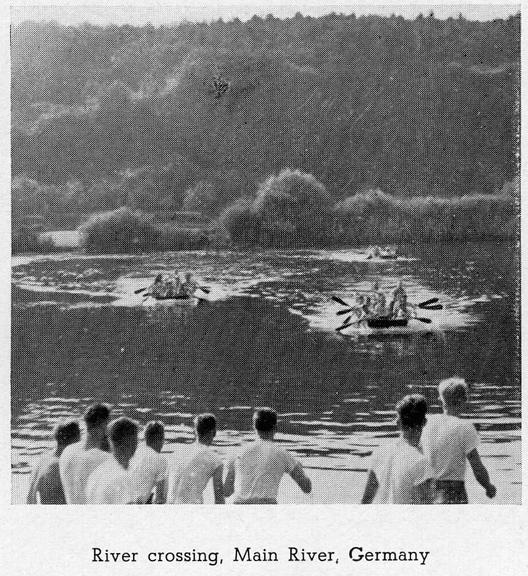
Each platoon operated with the
battalion to which it was assigned. Collecting, of course,
maintained its position with the
rear guard so that it might receive actual and simulated
casualties. During this time, Sgt. Weinshal was cited by
General Harper for skillfully and properly evacuating a simulated
casualty under simulated fire. Other men were,
either individually or collectively, cited for a very fine
performance.
Within a few days after the
entire company had moved to the new barracks at Schweinfurt's
Ledward Barracks,
the training was resumed. This was the first time since the
departure from Fort Benning that the entire company trained
together.
A review of the old subjects was
scheduled to enable the men to recall those subjects which they
might have forgotten.
This type of training continued until the company embarked upon
Exercise Combine.
It was on this problem that the
men got a fairly good idea of a fullscale operation. Evacuations
had to be made under
rigid circumstances. Men and units got lost during moves made
under cover of darkness. The essentials, such as:
control, communication, local security and logistics were
exercised. The men knew without further explanation being needed,
that these were vitally important. So important that, without
them, men could very easily be killed, wounded, or captured.
After ten days of field training, the Company returned to Ledward Barracks for further garrison training.
A new system of classified
subjects was introduced to relieve the men of the monotony of the
old subjects.
In reality, however, the old subjects were merely revised to
appear new.
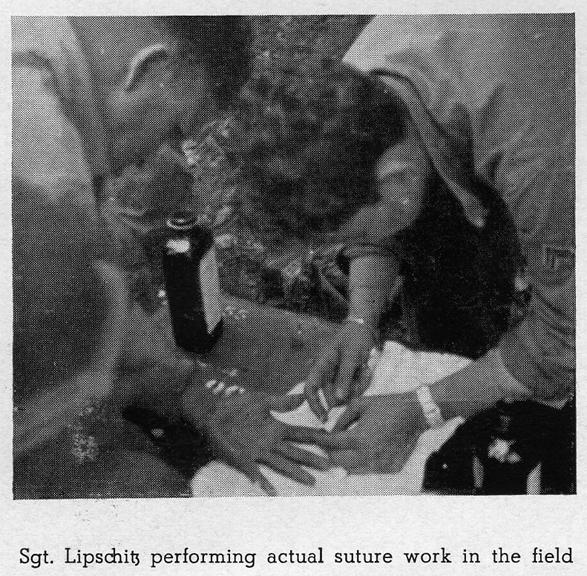
Anatomy and Physiology was
changed to Anatomy of Wounds. This course, taught by Sgt.
Andersen, gave the men a chance
to review the subject, and, at the same time, a chance to learn
more about wounds and their care.
A short course in Bacteriology
was given by Cpl. Stevens to teach the men the different types of
organic and tissue destruction
caused by specific organisms.
More plasma classes were given,
this time on an advanced basis. The number of men gaining an
opportunity to mix plasma
was increased. In order to better facilitate the proficiency of
each man in plasma technique, classes in veni-puncture were
added. With the aid of Major Garanflo, the Dispensary nurse,
three tables were set up with the sterile equipment necessary
to draw blood. The men were then paired off, drawing blood from
each other. The men learned to fill out a laboratory slip
and each man's blood was sent to Wiirzburg for analysis. At the
completion of this phase each man
was able to administer plasma alone.
There were some classes on
proper scrubbing technique. Here they were taught the correct
method of scrubbing for an
operation or any other type of sterile proceedure. From this the
class progressed to the right way to don cap, mask,
sterile gown and sterile gloves.
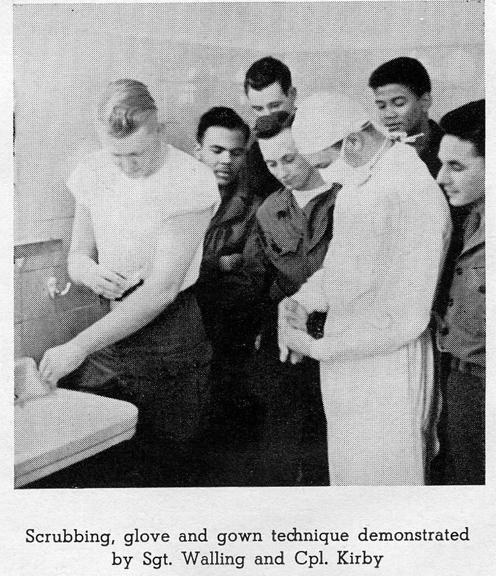
A series of classes to acquaint
the men on full fracture technique was introduced. This subject
covered plaster casts as well
as splints. The men were able to see the actual application of
plaster casts and splints. Later they had the opportunity,
themselves, to apply the plaster.
Further training in suturing was given; but this time the dummy was thin leather.
These latter classes all lead up
to a simulated full scale operation. A mock appendectomy was
carried out complete with patient,
suture nurse, surgeons, anesthetist, plasma, instruments;
everything complete. A training aid to simulate skin, facia,
muscle,
peritonium, caecum and appendix was placed on the patients
abdomen. He was draped and Sgt. Andersen took them
through the operation, step by step.
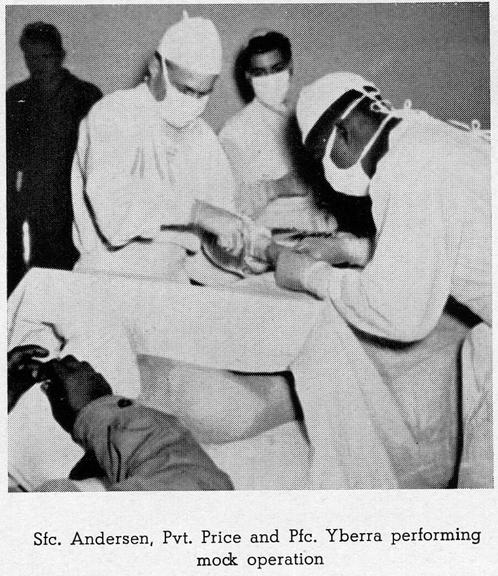
The one thing that was lacking in the training at Benning was training films, this was alleviated shortly after arriving at Schweinfurt.
Films on every possible phase of
medical training that were available were secured and shown.
These pictures gave polish
to the already acquired subjects. The men were able to see the
human body in operation by means of a series of Biological films.
Other films on combat and Korean war films rounded out this
period of training.
Soon, most of these men that
once came into the Medical Company as untrained medics will go
home to the states,
fully qualified to serve their country in any emergency as
experienced and fully qualified "men of mercy".
Some will remain in the Army, some will go into the active
reserve, but the majority will resume their civilian status.
Wherever they go and whatever they do, we that remain behind are
certain that they will continue on the same high standards
that they have set in Medical Company
The company is preparing to send
more untrained men through the same sort of rigid and thorough
training. It is the hope of all concerned
that they become as adept and confident as the ones that went
before. They have a high goal at which to shoot.
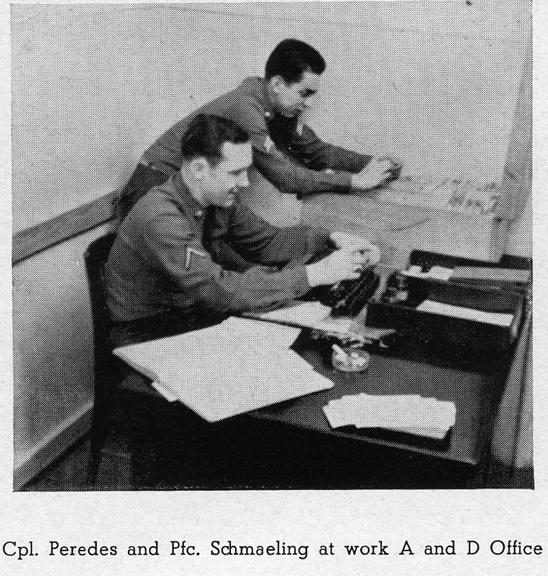
Home | Photos | Battles & History | Current |
Rosters & Reports | Medal of Honor | Killed
in Action |
Personnel Locator | Commanders | Station
List | Campaigns |
Honors | Insignia & Memorabilia | 4-42
Artillery | Taps |
What's New | Editorial | Links |